![]()
![]()
![]()
Use LEFT and RIGHT arrow keys to navigate between flashcards;
Use UP and DOWN arrow keys to flip the card;
H to show hint;
A reads text to speech;
44 Cards in this Set
- Front
- Back
|
What is Anatomical Position |
Body standing in a state of extension Feet slightly apart Hands supinated |
|
|
Define the anatomic locations and positions -Anterior -Posterior -Superior -Inferior |
Anterior - Front of the body Posterior - Back of the body Superior - Toward the head Inferior - away from the head |
|
|
Define the anatomic locations and positions -Medial -Lateral -Intermediate |
Medial - Toward the midline of the body Lateral - away from the midline of the body Intermediate - Between a more medial and a more lateral structure |
|
|
Define these anatomic locations and positions -Proximal -Distal -Superficial -Deep |
Proximal - Closer to the origin of body part or the point of attachment of a limb to the body trunk
Distal - Farther from the origin of a body part or the point of attachment of a limb to the body trunk
Superficial - Toward or at the body surface
Deep - Away from the body surface; more internal |
|
|
Distinguish Each Body Planes |
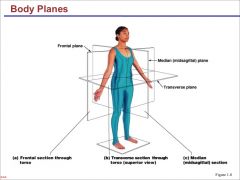
|
|
|
Name the 4 articulating surfaces
|
Condyle |
|
|
Describe each articulating surfaces |
Condyle-large, smooth round articulating oval structure
|
|
|
What are the 3 main types of depressions on bone |
Alveolus - Deep pit or socket in the maxillae or mandible Fossa - Flattened or shallow depression Sulcus - Narrow Groove |
|
|
Name the C.E.L. Projections for tendon and ligament attachment |
Crest - Narrow, prominent, ridgelike projection
Epicondyle - Projection adjacent to a condyle
Line - Low ridge |
|
|
Name the P.R.S. Projections for tendon and ligament attachment |
Process - Any marked bone prominence
Ramus - Angular extension of a bone relative to the rest of the structure
Spine - Pointed slender process |
|
|
Name the 3 T's in Projections for tendon and ligament attachment |
Trochanter - Massive rough projection found only in femur
Tubercle - Small round projection
Tuberosity - Large rough projection |
|
|
Describe the 4 Openings and spaces in bone markings |
Canal - Passageway through a bone
Fissure - Narrow, slitlike opening through a bone
Foramen - Rounded passageway though a bone
Sinus - Cavity or hollow space |
|
|
What are the main parts of Bone and identify them in a long bone |
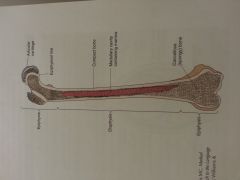
|
|
|
What are the main functions of bone |
-Support Soft tissue -Protects internal organs -Blood cell production -Movement |
|
|
How are bones classified? |
According to their shape Long Short Flat Irregular Sesamoid |
|
|
Examples of long bones |
Femur Tibia Humerus Ulna Radius |
|
|
Examples of short bones |
Carpals Tarsals |
|
|
Examples of irregular bones |
Vertebrae Sacrum Coccyx |
|
|
Examples of Flat bone |
Sternum Scapulae Ribs Pelvis |
|
|
Examples of Sesamoid bone |
Patella |
|
|
What are the 4 properties of muscle tissue |
Contractility Excitablility Extensibility Elasticity` |
|
|
Define agonist muscle |
Muscle or group of muscles responsible for action and movement |
|
|
Define antagonist muscle |
The opposing group of muscles to the agonist. They relax in order for the agonist to complete the movement and contract to act as a brake to the completed movement |
|
|
Define synergist muscle |
Prevents unwanted movement and also acts as fixators or stabilizers |
|
|
What movements do the sternoclavicular joint allow? |
Elevation/Depression Protraction/Retraction Anterior and Posterior Rotation |
|
|
What kind of joint is the sternoclavicular joint |
Synovial saddle joint |
|
|
What are the Ligaments of the Sternoclavicular joint? |
Interclavicular ligament Costoclavicular ligament Sternoclavicular ligament |
|
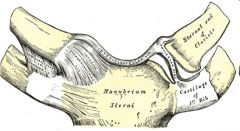
Describe the 2 S.C. Ligaments
|
Interclavicular - Limits SUP and LAT displacement of clavicle
Costoclavicular - Main support. Limits all ROM except depression
Sternoclavicular - Limits ANT and POS glide of clavicle |
|
|
Explain and describe the Acromioclavicular Joint |
Synovial plane joint
Restricts over arm movements |
|
|
What are the Ligaments of the Acro-clavi joint |
Coracoclavicular
Acromioclavicular
Coracoacromial |
|
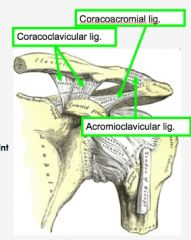
Explain the functions of each Acro-clavi joint
|
Coracoclavicular - Primary restraint to vertical displacement
Acromioclavicular - Prevents separation of clavicle and scapula
Coracoacromial - Forms roof over glenohumoral joint -- protection for bursa and supraspinatus tendon -- Provides limit to superior humeral head movement |
|
|
Describe and explain Glenohumeral joint and its ROM |
Synovial ball and socket joint
Flexion/Extension Abduction/Adduction Medial/Lateral Rotation Circumduction |
|
|
What are the ligaments of the Glen-humeral joint? |
Coracohumeral ligament
Superior/Middle/Inferior glenhumeral ligament |
|
|
Explain the functions of each glen-humeral ligament |
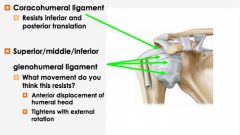
|
|
|
What are the elbow joints? |
Humeroulnar Humeroradial Radioulnar |
|
|
What types of movements do the elbow joint allow? |
Flexion/Extension Supination/Pronation |
|
|
Identify the ligaments of the elbow |
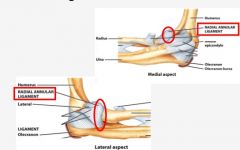
|
|
|
What are the joints of the axial region |
Atlanto-occipital joint
Atlantoaxial joint
Facet Joints (Zygapophyseal)
Invertebral Disc joints
Lumbosacral Joint |
|
|
What movements are allowed for the trunk |
Flexion (sagittal) Extension (sagittal) Rotation (transverse) Lateral flexion (frontal) |
|
|
What are the ligaments of the Axial region? |
ANT and POST longitudinal ligament
Ligamenta flava
Interspinous ligament
Supraspinous ligament |
|
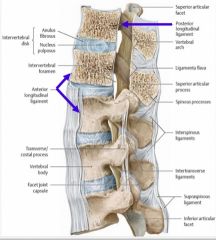
Describe the ant and post longitudinal lig and its function |
Ribbon like ligaments Attach at vertebral bodies and annulus
Function - Anterior resists excessive extension -- Posterior resists excessive flexion |
|
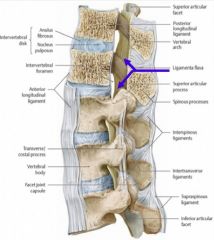
Describe and explain ligamenta flava
|
connects laminae of vertebrae 80% elastin 20% collagen
Function -limits flexion -Highly elastic -Elastin prevents buckling into spinal canal during extension |
|

Describe and explain the function of interspinous ligament |
-Connects adjacent posterior spines -Large angle of obliquity
Function -Limits flexion -Helps facet joints stay in contact |
|
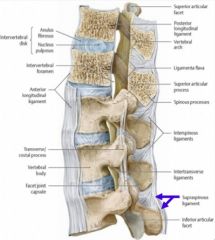
Describe and explain the function of the supraspinous ligament |
Connects the tips of spinous processes
Function -Resists excessive flexion |

